As the world economy powered into life after restrictions were lifted for the final time, pent-up demand and supply chain disruptions ignited an old enemy – inflation. Ever since, central banks have been playing catch-up andinterest rates have risen rapidly. However, as the Federal Reserve meets to discuss the next decision, they face somewhat of a crossroads. What path will they choose and what might that mean for investors? Our Senior Investment Specialist, Simon Durling, shares his thoughts in this week’s State of Play.
Key highlights from this week’s State of Play
- Crossroads
- US inflation data
- Federal Reserve decision
- Market update
Crossroads
When inflation began to resurface after the global pandemic, most central banks claimed the initial spike in price rises would be temporary. As we now know, this judgement proved to be wrong, prompting one of the fastest monetary tightening reactions (increasing interest rates and reducing the supply of money) in history.1 When eventually on 16 March last year the Federal Open Market Committee (FOMC) initiated the first increase in rates since the pandemic in March 2020, prompted a cut in rates, they increased rates by just 0.25%. Indeed, the Bank of England had fired the rate rise gun before them with their first rise in December 2021, albeit a smaller 0.15% increase. The key difference between the two important central banks since then has been the Federal Reserve’s appetite to be more aggressive with their rate rises, trying to tame inflation.
Interest rates
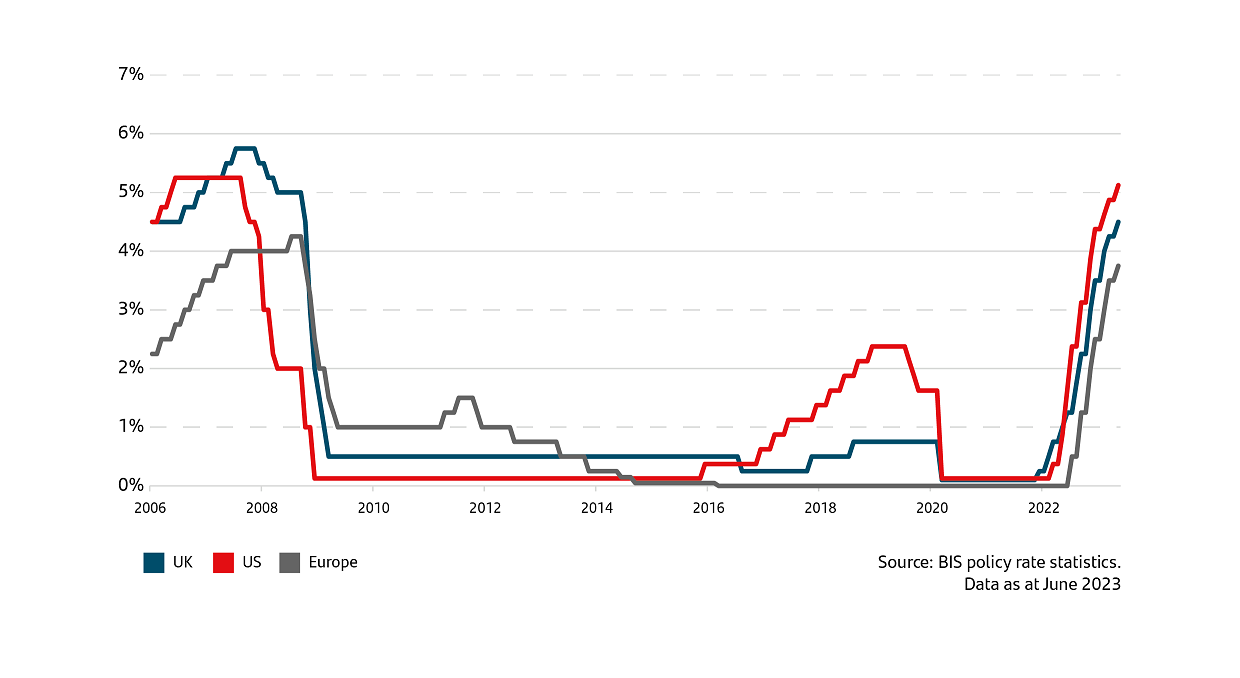
In the US, rates were increased by 0.75% on four consecutive occasions starting in June last year in an attempt to prevent price rises from creating long-term damage.2 It could be argued this aggressive approach was made possible by a strong US economy able to withstand rapid tightening alongside their ability to produce much of what they needed onshore to respond to such high demand, leaving them less reliant on the broken and disrupted global supply chain that had evolved over the last 30 years. Globalisation helped suppress prices as many companies outsourced manufacturing and distribution to cheaper areas in the world like China and India, until the pandemic and the disjointed approach to restrictions triggered a huge lack of supply, prompting sharp rises in the cost of making goods. The consequence of the US being more aggressive than other central banks and the US being more self-reliant ignited a surge in the value of the dollar, helping the US dilute price rises but forcing other countries and regions like the UK and the EU to import currency inflation on top of the imbalance in supply versus demand.
Now, following a sustained period of monetary tightening by raising rates and reducing the supply of money, the Federal Reserve has come to a crossroads with three possible options: raise rates further, pause rate rises, or cut rates. Given that core inflation remains stubborn and the strength of the US economy indicated by the previous week’s new jobs added was almost three times higher than forecast, it may be tempting to make just one more rate rise. Unfortunately, in their last meeting, the FOMC signalled that while they couldn’t guarantee that they would pause in June’s meeting, they indicated it was the most likely decision. Forward guidance, as it is called, is the central bank’s attempt to comment on why they make decisions and the outlook for future decisions to help market participants, and in particular, businesses, make decisions about borrowing and investment easier. Finally, if rate rises are designed to eventually tame rising prices, has it worked? The only true test of this is to assess inflation data. So, what did the latest US data that was released on Tuesday show?
Latest US inflation data
According to the U.S. Bureau of Labor Statistics, the headline rate for the US Consumer Price Index (CPI) fell in the 12 months to May from 4.9% to 4%, slightly lower than forecast. However, core inflation, which measures the changes in the price of goods and services excluding food and energy, only fell 0.2% in the 12 months to May from 5.5% (from April) to 5.3%, in line with market expectations. Despite core inflation being slower to fall, indications from the data showed used car prices contributed half of the monthly 0.4% rise in prices. With supply chains nearly back to pre-pandemic efficiency and an increase in new car production, policymakers will be grateful that aggressive interest rate rises are starting to combat the rise in prices but will have one eye on core inflation, probably concerned that this remains stickier than originally hoped. While market participants have been anticipating a pause in rates for this week’s meeting, the expectation is for a potential rate rise in July on the basis that they would rather go too high than not raise rates enough.
Overall inflation eases to lowest level in more than two years
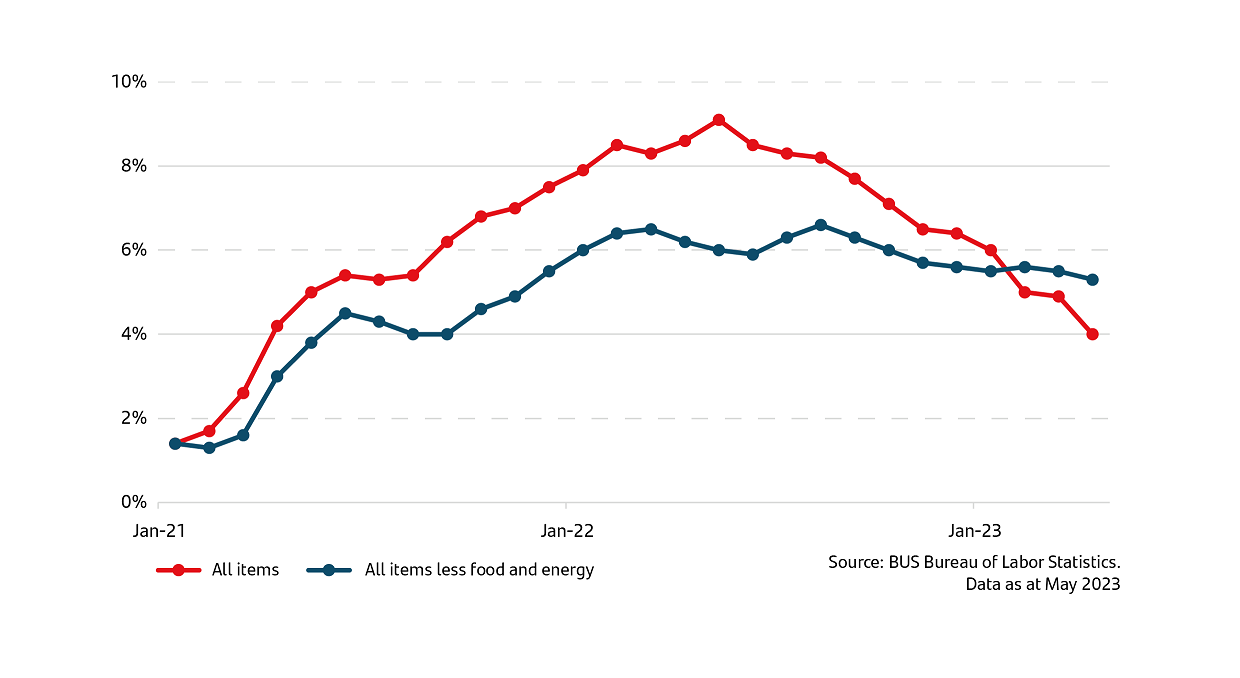
One aspect that provides some insight into the reasons for core inflation remaining stubbornly high is disposable household savings. Typically, this had been growing at a very stable rate for many years until the pandemic emerged. When restrictions were imposed in the US (and elsewhere in the world), individuals had to work from home, were unable to access many goods and services, spent less money travelling and commuting, confined to their homes with family. During this period, individuals saved more disposable income than in the preceding 20 years, which in the US was an enormous $2.6 trillion.3 So, why is this important? When restrictions ended, there was the expected surge in demand for things unavailable during lockdown, which triggered the initial reappearance of inflation. Much of these savings took time to be used and supported demand in the economy long after price rises began rocketing. If you look at the chart, since then, this large savings bank has started to be spent, reducing this pot of wealth in the US by $1.6 trillion.3 Clearly, this disposable savings is not the sole reason for inflated price rises, as higher earnings fuel greater consumer demand and higher prices for raw materials. Although this is down from last year’s peak, it remains in the price of most goods and services. Only energy costs (which are outside of the core calculation) have returned to pre-pandemic levels. What the savings insights combined with rising mortgage payments for many US households indicate is that the economy, while performing much better than anybody had anticipated, is beginning to slow, helping policymakers have more confidence when pressing the pause button.
Personal saving rates in the US
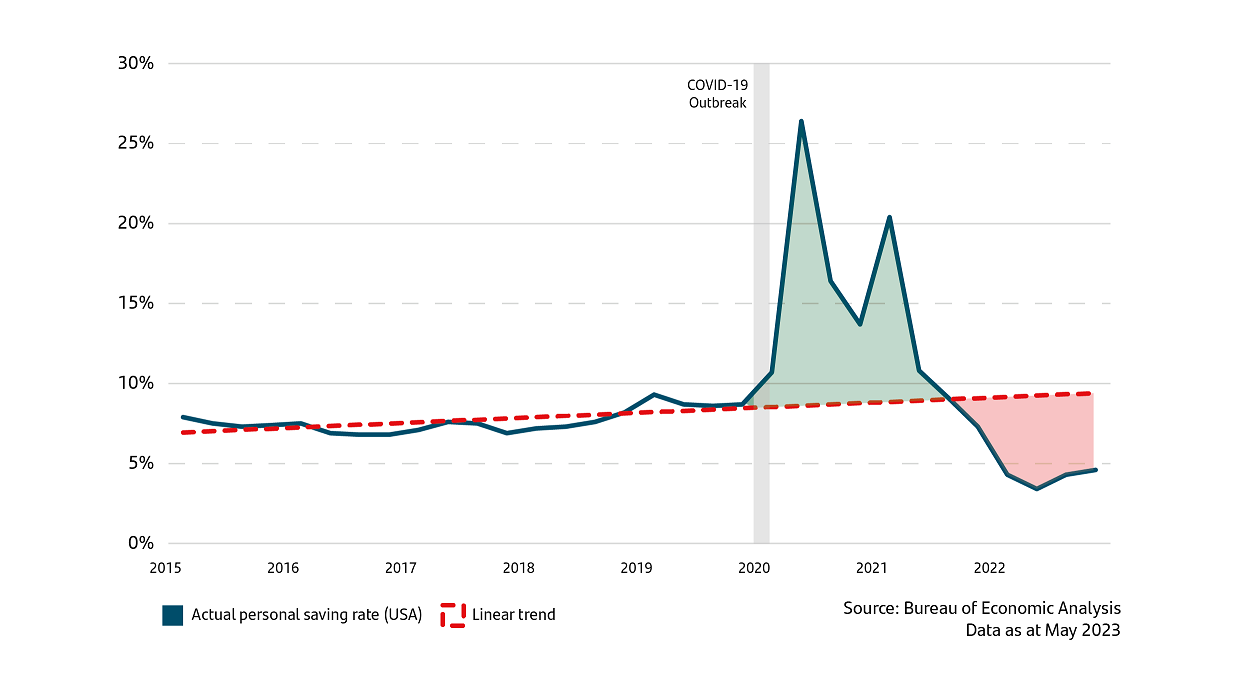
Federal Reserve decision
As expected, the Federal Reserve decided to leave interest rates the same for the first time since March last year after 10 consecutive rate rises.4 However, in an unexpected twist the Chairman of The Federal Reserve, Jerome Powell, struggled to articulate a clear outline of what to expect in future decisions leaving market participants and economists unconvinced about what this may mean for their next meeting due on 26 July and the subsequent meeting in September. He said in the following press conference at the end of their two-day meeting: “Nearly all committee participants view it as likely that some further rate increases will be appropriate this year. Inflation pressures continue to run high and the process of getting inflation back down to 2% per cent has a long way to go. The main issue we are focused on now is the extent of additional firming needed as it may make sense for rates to move higher but at a more moderate pace”.4 Many professional investors and market participants like fund managers and investment companies access voting tools which gather opinions across the market about what the market thinks will happen next. At the time of writing, these views varied indicating the decision to pause coupled with the intention to raise rates further sent mixed signals. Potentially this uncertainty stems from the previous future guidance last provided by the Fed indicating it may pause rates at this June meeting but promised to act if subsequent data provided sufficient evidence that further rate rise would be necessary. Most of the data since the last meeting in early May shows a resilient economy, ongoing tight employment market and stubbornly high core inflation which is slow to fall. All of which would suggest the June meeting may have seen a rate rise and then a pause. As it is, it has chosen to pause, and then further rate rises if necessary. As the importance of the world’s central banks has grown, especially since the global financial crisis, there is as much weight paid to their forward guidance as the final decision taken at each meeting. Navigating the communications with the market can be hazardous which dilutes credibility making it more difficult to manage market expectations in the future leading to less stable markets. It remains to be seen how any new data between now and the July meeting will influence policymakers final decisions.
Market update: touching bull market territory
Last year will be remembered as a remarkable year, in part because interest rates began to soar along with bond yields, sending their values plummeting. Shares also endured a tough year as interest rate rises began a re-evaluation of share prices. This tended to happen in waves as share prices fell sharply, followed by several bear market rallies. This happens when share prices fall, prompting some investors to see this as a buying opportunity, increasing demand and pushing share prices higher once again. When this initial momentum loses energy and further economic data like inflation numbers or company earnings disappoints, the whole process begins again. Last year, it happened several times. However, when you draw back to look at longer time frames, the picture looks less hectic and has a much smoother ride. Last week, the US stock market entered bull market territory, where the market has risen more than 20% since the last major trough, which in this case was October last year.5
S&P 500: touches bull market territory
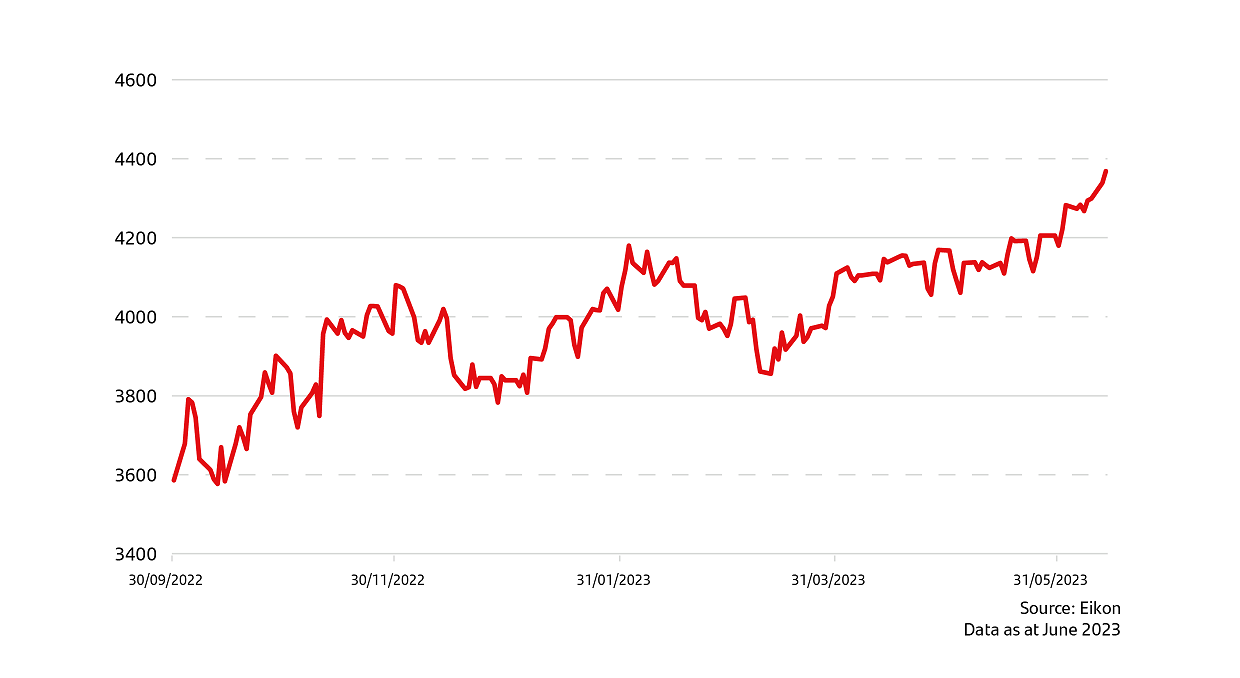
Many investors who have been brave enough in the last 6-9 months to have chosen to go ahead with their investments will be very pleased with their decision. One aspect that appears to have filtered into higher share prices in the last few weeks is that those who chose to sit tight have started to invest, pushing up demand and share prices. Whether this is sustainable remains to be seen, given the economic headwinds. The other important factor is the concentration of rises across the market as technology companies have stormed ahead. While there remains a bumpy road ahead, provided your timescale and risk comfort are matched with an appropriate portfolio, time in the market, not trying to time the market, is an old saying that still resonates for many.
The value of seeking guidance and advice
It is important to seek advice and guidance from a professional financial adviser who can help to explain how to build an appropriate financial plan to match your time horizons, financial ambitions, and risk comfort. If you already have a plan in place, or have already invested, it is important to allocate time to review this to ensure this remains on track and appropriate for your needs.
Performance
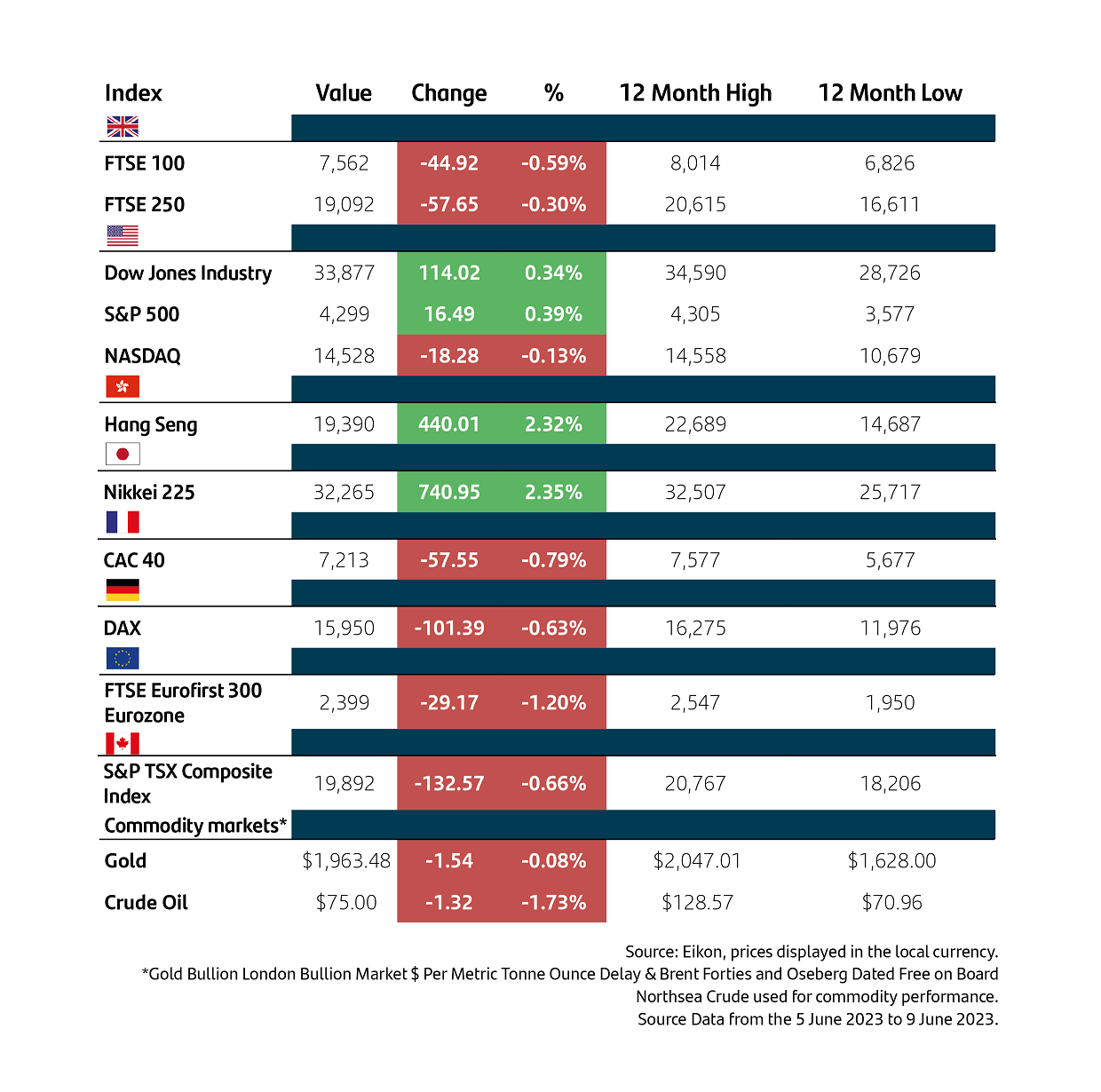
10-years bonds yields
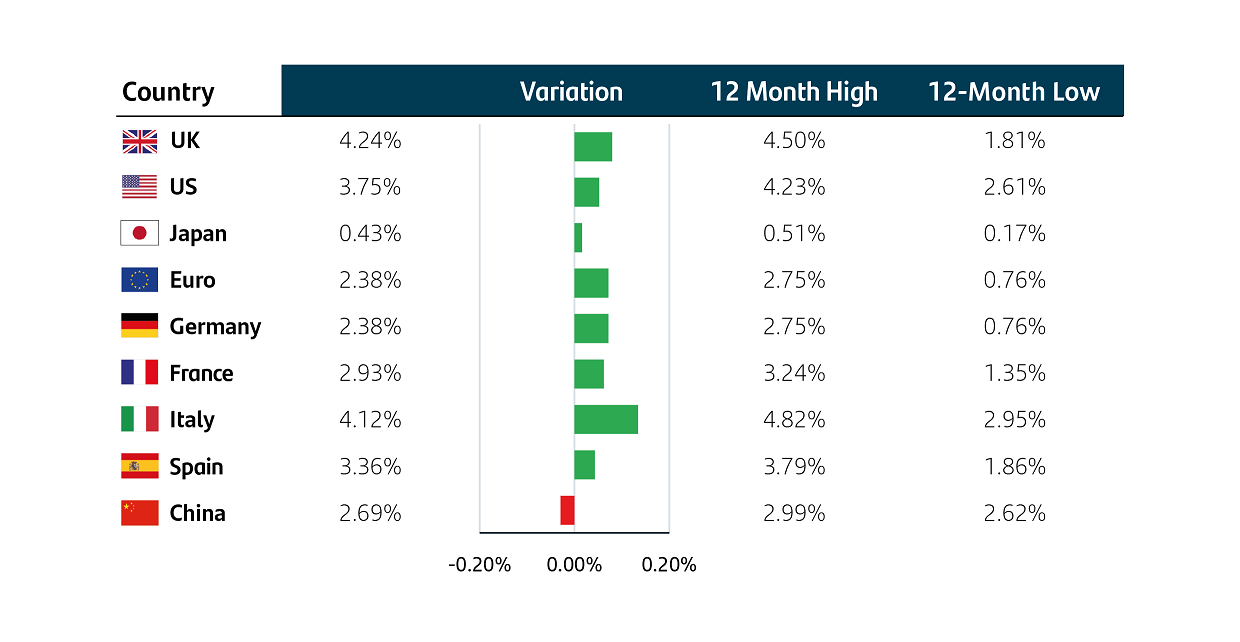
Currencies


Investing can feel complex and overwhelming, but our educational insights can help you cut through the noise. Learn more about the Principles of Investing here.
Note: Data as at 15 June 2023. 1 Investing.com, 13 June 2023. 2 Bank for International Settlements, 14 June 2023. 3 Bureau of Economic Analysis, 31 May 2023. 4 Eikon, 14 June 2023. 5 Financial Times, 15 June 2023.
Important information
For retail distribution. This document has been approved and issued by Santander Asset Management UK Limited (SAM UK). This document is for information purposes only and does not constitute an offer or solicitation to buy or sell any securities or other financial instruments, or to provide investment advice or services. Opinions expressed within this document, if any, are current opinions as of the date stated and do not constitute investment or any other advice; the views are subject to change and do not necessarily reflect the views of Santander Asset Management as a whole or any part thereof. While we try and take every care over the information in this document, we cannot accept any responsibility for mistakes and missing information that may be presented.
All information is sourced, issued and approved by Santander Asset Management UK Limited (Company Registration No. SC106669). Registered in Scotland at 287 St Vincent Street, Glasgow G2 5NB, United Kingdom. Authorised and regulated by the FCA. FCA registered number 122491. You can check this on the Financial Services Register by visiting the FCA’s website www.fca.org.uk/register




